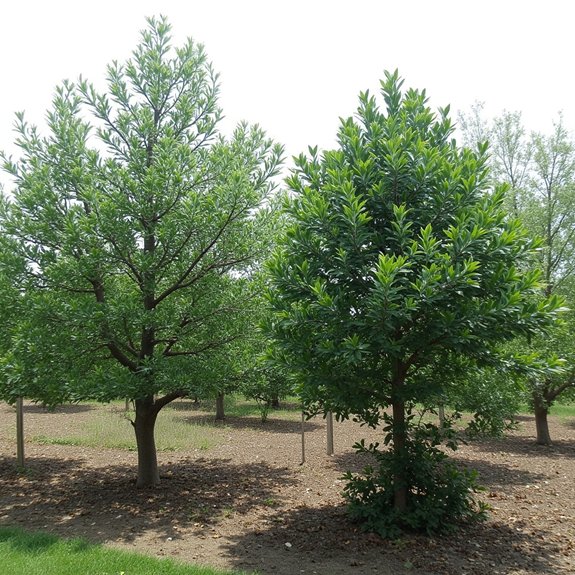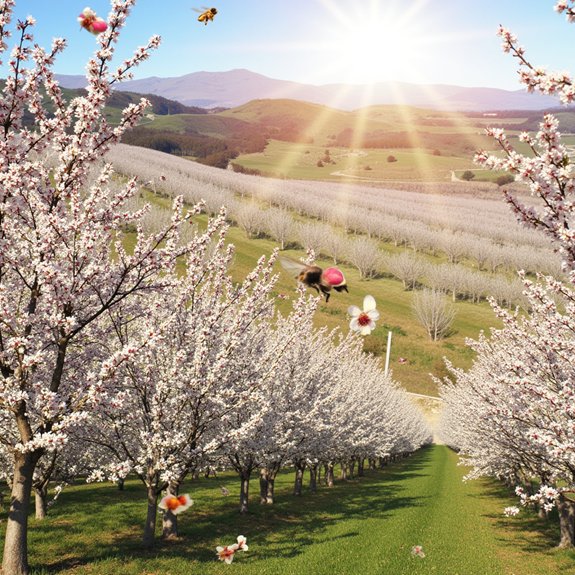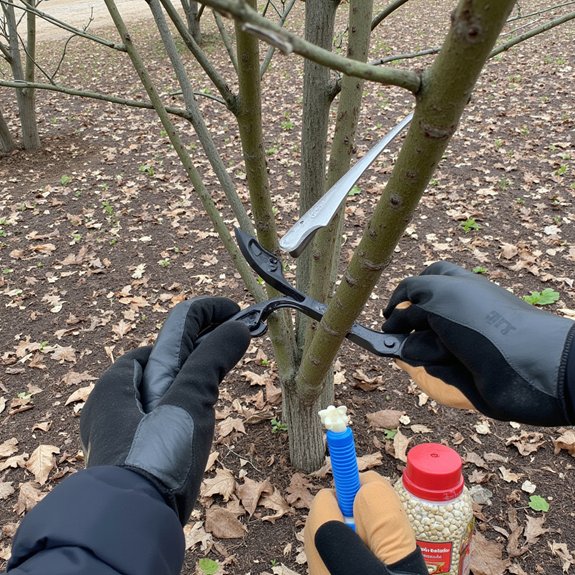Choosing between peach and apple trees requires careful consideration of several key factors that will impact your orchard for decades. Peach trees deliver faster gratification, typically producing fruit within three to four years, while apple trees demand patience with their six to ten-year maturation period. However, this initial timeline difference represents just the beginning of what separates these popular fruit trees, as their growth patterns, care requirements, and long-term productivity vary considerably in ways that might surprise novice gardeners.
Contents
Tree Size and Growth Characteristics

When choosing between peach and apple trees, understanding their size differences helps gardeners plan their orchard space effectively. Peach trees typically reach 25 feet in both tree height and width, though careful pruning can maintain them at 10-12 feet. Apple trees show more variation in their growth habits, ranging from 10-30 feet tall depending on the variety. Dwarf apple cultivars stay compact at 7-10 feet, making them ideal for smaller yards. Both species respond well to regular pruning, which controls size while improving fruit production and overall tree health.
Fruit Production Timeline and Tree Lifespan
Beyond size considerations, gardeners should understand the timeline for fruit production, as peach and apple trees operate on different schedules. Peach trees deliver faster gratification, producing fruit in 3-4 years with peak yields around year ten. Apple trees require more patience, taking 6-10 years before bearing fruit.
Tree longevity factors reveal striking differences in fruit yield comparison. While peaches offer quicker rewards, apple trees provide long-term investment value with lifespans of 35-45 years, some exceeding 100 years. Peach trees typically have shorter productive lives, making the choice between immediate satisfaction versus sustained harvest a key consideration.
Pollination Requirements and Climate Zones

Since fruit production depends heavily on pollination success, understanding each tree’s reproductive requirements becomes essential for garden planning. Peach trees simplify matters with their self-fertile nature, requiring only one tree for fruit production. Apple trees, however, demand cross-pollination from different cultivars to produce fruit successfully.
These pollination strategies directly impact planting decisions. Select apple varieties that flower simultaneously, or rely on neighboring gardens for cross-pollination support. Climate adaptability varies between species, with peaches thriving in USDA zones 4-9 and apples suiting zones 3-8. Both trees require adequate chill hours annually for proper fruit development.
Planting and Soil Preparation Essentials
Proper soil preparation forms the foundation for healthy fruit tree establishment, requiring careful attention to drainage, pH levels, and soil composition. Both peach and apple trees thrive in slightly acidic conditions with pH levels between 6-6.5, making soil testing essential before planting.
Well-draining soil types prevent root rot and disease, as standing water proves fatal to fruit trees. Effective planting techniques involve digging holes twice the root ball’s width, mixing compost into existing soil, and removing all weeds from the area.
Plant trees immediately after purchase to minimize transplant shock and stress on developing root systems.
Ongoing Care and Maintenance Practices

Maintaining fruit trees requires consistent attention throughout the growing season, with specific timing essential for ideal results. Proper watering practices involve deep, infrequent sessions during early growth stages, while mature trees typically survive on natural rainfall alone. Adequate drainage prevents root rot and disease development.
Effective pruning techniques focus on creating open centers using 3-5 major limbs, promoting airflow and sunlight penetration. Light pruning works year-round, but heavy structural work should occur during winter dormancy. Regular fruit thinning reduces branch stress and improves energy distribution throughout the tree for better overall production.
Fertilizing Schedule and Harvest Methods
Beyond the physical care of pruning and watering, fruit trees depend on strategic feeding schedules that differ greatly between apple and peach varieties. Peaches require twice-yearly feeding with 10:10:10 fertilizer, once in early spring and again in late spring or summer. Apple trees need only annual fall feeding after leaves drop.
Apply fertilizer types in a circle eighteen inches from the trunk, expanding outward as trees mature. Monitor growth for additional nutrient needs.
Harvest timing varies greatly: peaches ripen June through August when yellow and easily twisted off, while apples reach maturity August through October, showing full color and twisting easily from stems.
Culinary Applications and Kitchen Uses
Both peaches and apples offer remarkable versatility in the kitchen, transforming from simple tree-to-table snacks into elaborate desserts and preserved goods. Fresh peaches shine in cobblers, pies, and fruit salads, while their natural sweetness makes bottling and jam-making effortless. Apples excel in traditional applications like apple butter, sauce, and tarts, though they’re equally delicious as raw snacks.
Various cooking techniques enhance both fruits’ flavors. Baking, sautéing, and preserving reveal different taste profiles. Recipe ideas range from simple preparations to complex desserts, with both fruits lending themselves to jellies and jams that capture seasonal flavors year-round.
